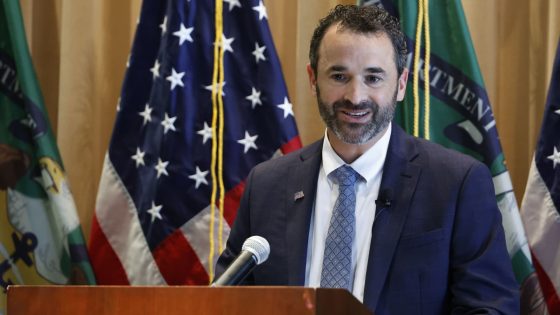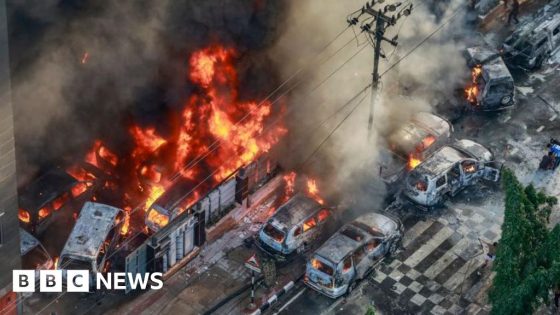May 19—Somewhere on the Campbell Creek trail, an abandoned campsite stretches from the bank of the creek all the way to the asphalt of the trail. There are bike wheels and wet wipes and tarps and tires. There are empty pill bottles and wet bloated pages of books. Amid unfurling ferns and shoots of cow parsnip, there are signs of a fire.
It’s a scene repeated along Anchorage’s greenbelts and trail systems: A sprawling camp on the banks of Chester Creek, with American flags hoisted from trees. A person eking out a spot for a sleeping bag under an overpass. A patch of the Tony Knowles Coastal Trail where tents are strung up along the mudflats.
Camps in Anchorage’s green spaces are nothing new. But entering a third summer of unstable shelter options for an unhoused population the city estimates at about 900, there’s a sense that things are different this spring. Officials, trail users and unhoused people themselves say they are seeing more camps, more ecological damage and more destruction.
Trash in camps has gone “through the roof,” said Alexis Johnson, the city’s homeless coordinator. “I think that has changed drastically.”
The “landscape of homelessness” in Anchorage can change so much in a year, she said.
Some say they feel heartbroken by the state of Anchorage’s trails at the same time they feel compassion for homeless people trying to make it in the city. They remind that unhoused people face dire threats to their health and safety daily. Ten have died so far this year.
Others are just fed up.
It’s likely that outdoor camping will only increase: In addition to the roughly 560 people the city estimates are living in Anchorage greenbelts, as of June 1 the 160 or so people living in non-congregate shelter rooms at the Aviator Hotel will be out on the street. The city hopes to secure state funding to continue operation of a separate congregate shelter operating off the Old Seward Highway that currently houses 197 residents, with possible help from the Anchorage Assembly. A U.S. Supreme Court decision anticipated in June that may change the rules for cleaning up existing camps.
But even if the city has more latitude to clear camps, a core issue remains: People who have nowhere indoors to live will live outside in Anchorage public spaces. The city parks department hears regularly from people who are upset by camps in city green spaces, and some who say they no longer use the trails because of them.
“What breaks my heart is when people stop going out on the trails because they no longer feel safe,” said Mike Braniff, the city’s director of parks and recreation.
Dan Braden has a different perspective. Homeless for years, he sat on a sunny recent afternoon in his own tarp-covered tent, on a grassy hill above the Alaska Railroad depot near Ship Creek.
“Do you think we feel safe on the trails?”
Along Campbell Creek
Braniff stopped on a bridge over Campbell Creek on a still frosty recent morning. He looked at a large camp, with trails carved out of the forest and a series of shacks, some with hard walls. It appeared as if someone had driven an RV into the forest and dumped it.
City crews clear or “abate” camps once they get the legal go-ahead. Because they city doesn’t have adequate indoor shelter to offer, a federal Ninth Circuit court decision has held camps can’t be cleared except under special circumstances such as an immediate risk to health or safety, or wildfire danger. That may change with a U.S. Supreme Court decision.
Priority goes to camps that pose the most urgent concerns. The city has received 841 reports from the public about camps so far this year — 603 in the past month, according to a municipal dashboard. A total of 53 camps have been abated this year, with the parks department removing 163 tons of trash. That’s about the weight of an adult blue whale.
“There’s a lot of camps in Anchorage right now,” Braniff said. “And I think as a department, we’re aware of most of them, but we’re not aware of every single one of them.”
Recently, his crew leveled a huge camping area near Cuddy Park in Midtown. It took dozens of people, heavy equipment and days to get it done. All of the 120 or so people who’d been living there were offered indoor shelter, said city homeless coordinator Alexis Johnson. Only five took the offer.
Some of the others are living in vehicles “scattered with people just trying to survive ,” said Apollo Naff, who owns some of the vehicles.
With the advent of the CWS congregate shelter on nearby 56th Street, camps have grown along the Campbell Creek trail in places where they didn’t used to be. Its not surprising to Braniff that more camps are popping up along the Campbell Creek trail. There’s clearly an association between locations of camps and where people can get services at a shelter, he said.
Johnson said she’s noticed a shift in the demographics of people living in trailside camps: In the past, people with alcoholism and well into middle age have been among the main camp constituents, at least in the more out-of-the-way areas along greenbelts.
“For the most part we have people who have camped outside for years and years and years,” Johnson said. “And they keep their space clean and just want to be left alone.”
These days, the camps seem to be full of younger people, Johnson said. Drugs, particularly deadly and dirt-cheap fentanyl, seem just as if not more prominent than alcohol. There’s more garbage, more fires, more shopping carts in creeks, more destruction, she said.
Illegal camps surely are causing environmental damage to the waterways, said Cherie Northam, the director of the Anchorage Waterways Council.
But so far, it has been hard to quantify: Fecal coliform testing doesn’t differentiate between pet and human waste, and more advanced testing to search for other trace elements that could be found in trash dumped in or near the creek hasn’t happened.
Northam herself lives along a stretch of Campbell Creek that has in recent years become the site of camps. There have been propane tanks and generators. Once, a propane tank exploded.
Recently, she drove to Cuddy Park, where at one time people parked to walk around a duck pond. Her organization has put up signage warning people not to feed the ducks. That didn’t seem like the problem any longer, she said: The parking lot was full of garbage and broken down cars, an extension of the nearby camp.
“The cars, the trash,” she said. “I mean, it’s heartbreaking.”
Tent City
Dan Braden and his friends Jamie Lockman and Ignatius Tyson recently sat in a mountain-facing tent above the Alaska Railroad depot.
The area nearby was known as “Tent City” a hundred years ago in Anchorage’s very early days. The city had announced it would tear the camp down on Friday, a process known as “abatement,” a bureaucratic term nevertheless familiar to many unhoused people.
Braden and Tyson have been homeless for many years. Lockman not as long. She’d held office jobs before. She’d had an apartment in Homer for a time. But she’d ended up back in Anchorage and homeless, living in her car.
The growth of camps along trails will continue as long as housing is hard to find in Anchorage, Braden said. Moreover, some people do not want to live in shelters, Braden said. Maybe they’re worried about bed bugs or unfriendly security guards or their fellow shelter residents. They are adults who don’t appreciate having a curfew, like some of the city’s non-congregate shelter sites impose, Lockman said.
“Out here,” Braden said, “We can have a family we choose around us.”
Lockman said she’d camped by a trail before. She tried to keep camp clean. Trash was the quickest way to draw complaints and trouble.
“I was respectful for the people using the trails,” she said. “I was also very grateful when they were respectful — it was a two-way street.”
They said they felt the judgment of Anchorage residents who looked on their home with disgust. They saw the people on the tour buses drive by, eyeing them. When the city came to break down the camp on Friday, Tyson wondered about his belongings. How would you like it, he asked, if someone came and took your possessions away from you?
Tyson said he wondered why the 3rd and Ingra site couldn’t open to camping again. Why people couldn’t live inside some of the many abandoned buildings in Anchorage. People wouldn’t be living along trails if they didn’t have to, he said.
Expand
Autoplay
Image 1 of 17
James Roberts eats a peanut butter and jelly sandwich as he packs some of his belongings during a homeless camp abatement on Friday, May 17, 2024 on a downtown hillside overlooking the Alaska Railroad depot. Roberts said he had been camping at that spot for a year, and he didn’t know where he would sleep that night. (Loren Holmes / ADN)
Back on the trail
Back on the Campbell Creek trail, Braniff, the parks director, showed where a crew would enter a camp to pack up belongings left behind. Trash has to be trucked to the Eagle River dump site. He guessed it would take a half dozen people weeks to clean. Some damage lingers, like compacted trails where vegetation won’t grow.
Just then, Justin Chevront popped out of a tent with his Trek bike and walked to the trail. Chevront doesn’t live in the camp, he said. He’s an exploration geologist with a wife, two kids and a home in East Anchorage. But he’s friends with some guys who do live there, fellow veterans, he said. They are fighting their own personal battles.
He’s tried to help the men construct safe shelters for subzero temperatures, using Mylar and special plastic sheeting to retain warmth. He doesn’t want people to freeze. Chevront spends a lot of time on the trails on his own bike and with his unhoused friends, who he says are world-class bike mechanics and riders in their own right.
He too is convinced that things have generally gotten worse: Bigger camps, new places. More destruction. He thinks fentanyl is a contributing factor. Fixing it will be about more than spending money, he thinks.
” I think it’s much deeper than that,” he said. “There are those who are going to be out here because they want to be here and then there are those who want to quit, but just don’t don’t see a way forward without without bureaucracy and red tape. It’s both appalling to me. And motivational to me.”
Source Agencies




